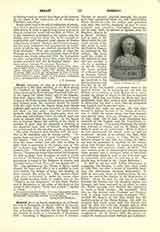

Breast, STRIKING OF the, as a liturgical act is prescribed in the Holy Sacrifice of the Mass during the Confiteor at the phrase “Through my fault” (three times), at the Nobis Quoque Peccatoribus (once), at the Agnus Dei (three times), and at the Domine, Non Sum Digit’s (three times). With bowed head, except at the Nobis Quoque Peccatoribus, moderately and without noise, the celebrant strikes his breast with the right hand, the fingers being held closely together and curved or fully extended, as the rubrics are silent on this. point; after the consecration, however, with the last three fingers only, since the thumb and index finger, which are joined, must not come in contact with the chasuble. At the Agnus Dei in requiem Masses the striking of the breast is omitted, to show that the celebrant is thinking of the departed more than of himself. The faithful are accustomed to this practice as well as the priest.
The early Christians were familiar with the practice, as St. Augustine and St. Jerome testify. “No sooner have you heard the word `Confiteor‘”, says the former, “than you strike your breast. What does this mean except that you wish to bring to light what is concealed in the breast, and by this act to cleanse your hidden sins?” (Sermo de verbis Domini, 13). “We strike our breasts”, declares St. Jerome, “because the breast is the seat of evil thoughts: we wish to dispel these thoughts, we wish to purify our hearts” (In Ezechiel, c. xviii). A warrant for these statements is found in the Psalmist: A contrite and humbled heart, O God, Thou wilt not despise (Ps., 1, 19). The petitioner at the Throne of Mercy would chasten his heart and offer it as a sacrifice to God, who healeth the broken of heart and bindeth up their wounds (Ps. cxlvi, 3). The ancient Christians were accustomed to strike the breast when they heard mention made of sensual sins; at the “Forgive us our trespasses” of the Pater Noster; and in detestation of the crime of the Jews, at. the words of the Gospel, “Thou hast a devil”, applied to Christ.
ANDREW B. MEEHAN

